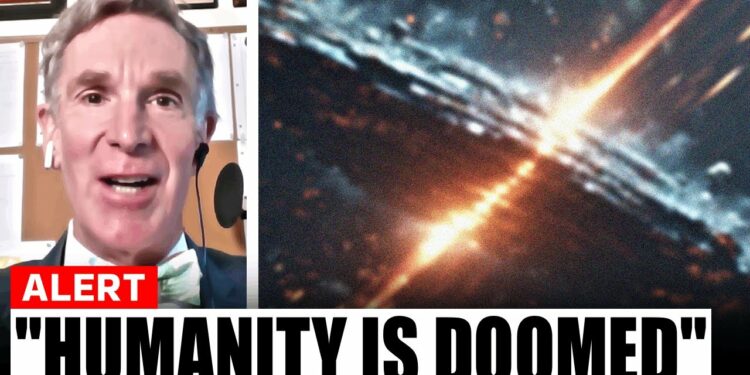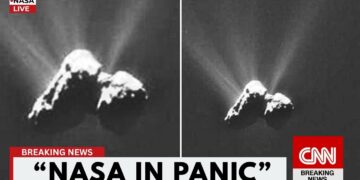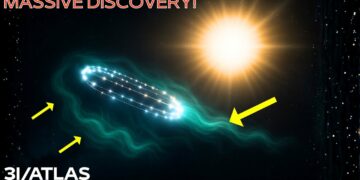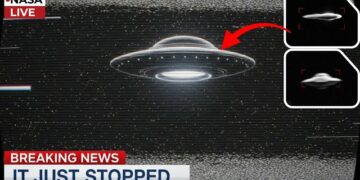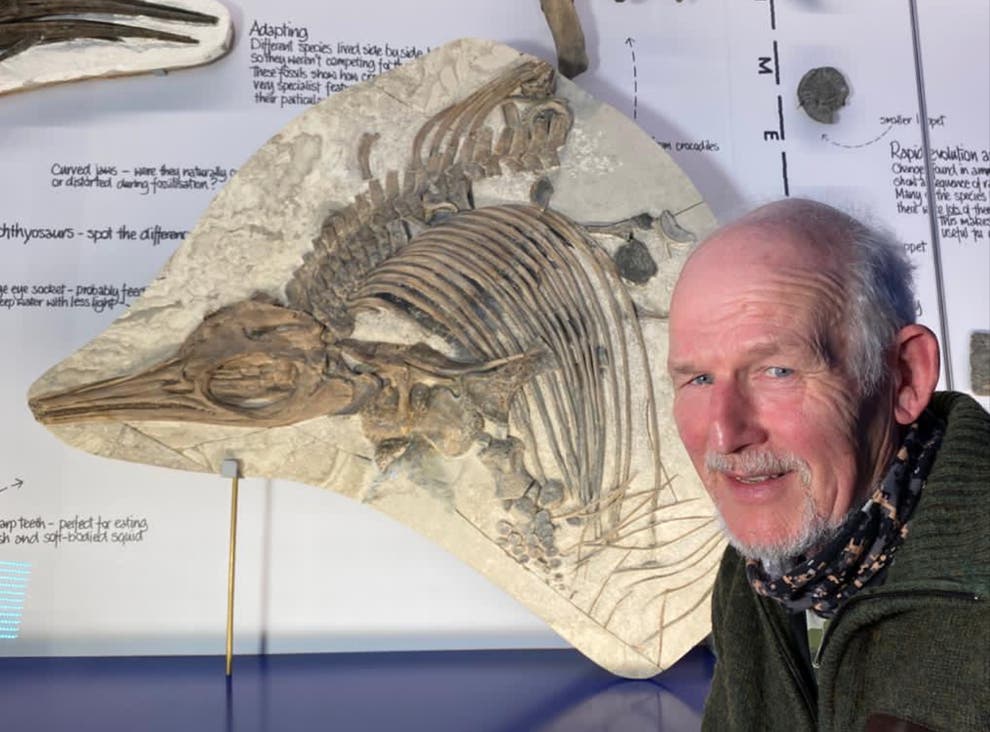New images of ThreeI Atlas, the third interstellar object ever observed from Earth, have surfaced as it races through our solar system. This newly detected interstellar visitor, dubbed Three Eye Atlas, is only the third of its kind ever spotted, speeding into our solar system from the unknown depths of space. Unlike objects bound to the Sun, it carries secrets from uncharted regions. Scientists remain uncertain about its implications, and Bill Nye has issued a serious warning, suggesting this is not something to ignore. Could Three Eye Atlas pose a hidden threat?
Beyond the headlines, ThreeI Atlas is often dismissed as just another space rock. However, what’s unfolding is rewriting our understanding of the universe. Mainstream coverage focuses on the basics: it’s moving at 60 km/s, it’s the third interstellar object ever detected, and it’s exhibiting unusual nickel emissions. But this misses the bigger picture. The nickel emissions aren’t just odd—they’re physically impossible based on our understanding of cosmic chemistry. When metals heat up in space, they don’t separate into pure elements, a process that requires massive industrial systems on Earth. Yet, Three Eye Atlas is ejecting pure nickel without the expected accompanying iron. Moreover, why is no one addressing the object’s trajectory? The odds of it randomly passing near Venus, Mars, and Jupiter while moving retrograde through our solar system are astronomically low—something that shouldn’t happen even once in thousands of years of observation.
Yet, here it is, threading a cosmic needle with inexplicable precision. Scientific papers are cautiously avoiding the implications, but the truth is clear: either we’re witnessing the luckiest coincidence in astronomical history, or something far more deliberate is occurring. The scientific establishment’s attempts to normalize this are baffling. Statements like “we need more data” or “unusual but not unprecedented” are misleading. No other object in astronomical records has shown this combination of traits. The pure nickel outgassing alone should have sparked global emergency scientific summits, yet carefully worded press releases downplay its strangeness, as if there’s an unwritten rule in astronomy: don’t suggest anything truly extraordinary, even when the evidence is undeniable.
The carbon dioxide-to-water ratio is another underreported anomaly. Every comet studied has water as the dominant volatile component—Comets 101. But Three Eye Atlas is almost entirely carbon dioxide, with water barely detectable in spectral analysis. This isn’t just unusual; it’s like finding a car running on orange juice instead of gasoline. It fundamentally challenges our understanding of how comets form and function, yet it’s breaking all the rules.
Behind closed doors, astronomers are having late-night discussions about patterns in the data they can’t explain and are hesitant to report officially. The carbon dioxide-to-water ratio maintains a mathematically precise 8:1 relationship, fluctuating by no more than 0.02% since observations began. Natural processes don’t exhibit such precision over time—they’re messy, fluctuating with changing conditions. This stability is making researchers uneasy.
Then there’s the unreported radio frequency monitoring. Three separate listening stations have detected faint but structured signals from the direction of Three Eye Atlas. No one is claiming it’s communication—nobody wants to take that leap—but the signals show patterns unlike any known natural emission spectra. The official explanation of “instrument anomalies” is losing credibility as more telescopes detect the same signals. A scientist at Greenbank reportedly double-checked their equipment and confirmed the signals weren’t local.
The dust particles surrounding Three Eye Atlas are another anomaly not discussed publicly. Unlike typical comets, where dust forms a random cloud pushed into a tail by solar radiation, high-resolution imaging from the James Webb Telescope shows the dust organizing into distinct, onion-like layers. Some particles even appear to move against solar radiation pressure, which should be impossible unless they’re self-propelled or influenced by localized magnetic fields that shouldn’t exist. Researchers studying this won’t go on record because it defies conventional physics.
NASA’s Jet Propulsion Laboratory reports that Three Eye Atlas maintains a near-constant surface temperature of 250 Kelvin (-23°C or -10°F), despite varying distances from the Sun. At its current distance, it should be closer to -100°C. Something is either generating heat internally or manipulating solar radiation in ways that defy our understanding of thermodynamics in space. Scientists are repeatedly checking their instruments because the readings make no sense.
The trajectory’s statistical improbability is staggering. A 0.005% probability isn’t just unlikely—it’s effectively impossible by random chance. To put it in perspective, it’s more likely to shuffle a deck of cards into perfect numerical order by suit than for a random interstellar object to follow this path. Moving against the solar system’s flow, it weaves past three planets with near-perfect precision. Unlike typical fast-moving objects, which get gravitationally slingshotted unpredictably, Three Eye Atlas maintains its course with minimal influence from planetary encounters. It’s like a bullet dodging raindrops without changing direction. Planetary defense analysts, whose models accurately predict asteroid paths, are baffled, as Three Eye Atlas’s behavior—whether due to its mass, composition, or possible course corrections—defies all natural models.
The planetary flybys are suspiciously optimal. The Venus approach in September 2025 brings it within 0.08 astronomical units—close enough for detailed observation but far enough to avoid gravitational disruption. The Mars flyby in November and Jupiter encounter in January 2026 follow the same pattern, as if designed for maximum Earth observation while maintaining its path. All flybys occur when the planets are on the same side of the Sun as Earth, ensuring visibility. If they happened on the Sun’s far side, we couldn’t observe them—another “coincidence”?
The entry angle into our solar system adds further improbability. Most interstellar objects should enter along the galactic plane, where matter is distributed. Three Eye Atlas entered at nearly 90° to the galactic plane, diving in from above—an energy-inefficient approach that defies natural gravitational influences but allows a comprehensive survey of our planetary system. At what point do coincidences become patterns suggesting purpose?
The nickel emissions raise deeper questions. Spectroscopic analysis shows the nickel particles, ejected 10,000 km from the object, arrange into organized patterns too structured for normal electromagnetic interactions. Some scientists suggest the nickel behaves like a self-assembling nanostructure, showing geometric regularities akin to advanced Earth-based molecular manufacturing. If Three Eye Atlas is producing structured materials rather than randomly outgassing, it implies a technological process beyond our capabilities. The nickel’s 99.97% purity, far exceeding natural deposits or industrial refining, suggests an enormous energy source with no visible explanation—no nuclear reactions, no solar collectors. The emission cycle, with 17.5-minute bursts followed by 42.3-minute lulls, repeats with computer-like precision, unlike natural outgassing, which is continuous or irregular. Some researchers are even exploring if these cycles encode information.
Historically, interstellar visitors aren’t new. The Great Comet of 1844 puzzled 19th-century astronomers, and digitized logbooks describe anomalous transients resembling Three Eye Atlas. Military tracking systems have occasionally detected fast-moving objects that vanish quickly, but these rarely enter scientific literature due to their classified nature. Ancient records, like Song Dynasty “guest stars” or medieval Islamic “wandering lights,” describe objects moving against expected paths, dismissed as errors but possibly legitimate. Modern systems like Pan-STARRS and NASA’s NEOWISE have detected potential interstellar objects too faint or fast for confirmation, suggesting Three Eye Atlas may not be rare but simply detectable due to its size and activity.
The divide between science and speculation is artificial. Planetary rings, black holes, and exoplanets were imagined before confirmed. Three Eye Atlas may be at a similar juncture. Ronald Bracewell’s 1960 concept of autonomous probes exploring habitable systems aligns eerily with its traits: unexplained energy use, unnatural stability, intentional-like paths, and material processing resembling manufacturing. Dismissing this outright isn’t caution—it’s arrogance. The honest stance is that Three Eye Atlas’s characteristics defy our understanding of natural interstellar objects. Whether they reveal new natural processes or something extraordinary, the wonder lies in embracing the unknown with rigor and open-mindedness.
Three Eye Atlas tests our intellectual humility. Its techno-signature-like traits—energy use, stability, trajectory, and material processing—push us to rethink what’s possible. Even if natural, it’s expanding our cosmic perspective. What are your thoughts on Three Eye Atlas? Share below, and stay updated by liking and subscribing.

